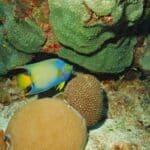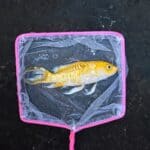Swim bladder is a condition that affects all fish species with a swim bladder, not just angelfish. The organ helps fish float. When compromised, it affects their ability to swim or change depth.
Constipation is the most common reason, so giving the angelfish an Epsom salt bath and feeding it peas can help loosen its bowels. You should stop feeding the fish for 3 days before beginning treatment.
Antibiotics are required when a bacterial infection causes swim bladder disease.
Keeping the water’s conditions and temperature at the right level is the best means of prevention.
Cichlids are more prone to swim bladder problems than other fish. While the disease is easy to treat, you must determine the reason for the fish’s condition before selecting a treatment.
Can Angelfish Get Swim Bladder?
Swim bladder is a common health complication among angelfish. It’s a condition where the fish’s swim bladder stops working correctly. There are many causes, including:
- Physical abnormalities.
- Diseases.
- Bacterial infections and parasites.
- Low water temperature.
- An unsanitary environment.
- Accident and injury.
- Mechanical factors.
Swim bladder is unique because it isn’t a single disease but a collection of issues that affect the organ.
It’s more common amongst goldfish, bettas, and cichlids, but as we’ve already mentioned, all fish with a swim bladder are susceptible, including angelfish. Two types of swim bladder problems can affect fish:
- Negative buoyancy (sinkers): The fish can’t maintain neutral buoyancy, so they lay at the bottom.
- Positive buoyancy (floaters): This causes the fish to float to the water’s surface.
You can tell which one afflicts the fish by how it floats around the tank.

What Does A Fish’s Swim Bladder Do?
According to Scientific American, the swim bladder is a thin-walled sac inside the fish’s body.
It’s a unique organ usually filled with gas or oxygen that helps the fish maintain perfect buoyancy, preventing it from floating to the top or sinking to the bottom of a tank or the ocean.
It inflates when the fish wants to move up and deflates when it wants to go down, a little bit like a balloon.
The swim bladder also acts as an eardrum and a secondary source of hearing to the ears, helping fish detect sounds.
When sound hits the air, the swim bladder vibrates, which fish pick up on. PLOS One describes how the bladder’s size can extend the frequency range up to 3 kHz.
That’s why the swim bladder is so essential to fish. The fish is vulnerable to predators, starvation, injury, and secondary health conditions without one that functions properly.
Where Is The Swim Bladder Located?
Basics in Human Evolution explain that the swim bladder is located right above the digestive tract and below the spinal vertebrae. It sits below the kidney and beside the top portion of the pleural ribs.
What Causes Swim Bladder Disease?
The exact cause of swim bladder is currently unknown, but it’s thought that the following factors play a significant part in the condition’s development:
Overfeeding
Overfeeding is one of the leading causes of swim bladder disease.
Angelfish eat more food than they need. In the wild, they don’t know when their next meal will come. When they find food, they usually have a period of a few days where they go hungry.
The problem with overfeeding is that the fish become constipated, which causes fatty deposits to build up around the bladder.
Also, when angelfish eat, they gulp down air from the surface. The additional air affects their swim bladder, causing it to become enlarged and swollen.
Only feed your angelfish enough food to eat non-stop for 30 seconds. Also, remove any food your fish haven’t eaten before it starts to taint the water and cause harmful chemicals to build up.
Light, Floating Foods
Light, floating foods such as pellets and flakes are thought to cause swim bladder.
They expand with water in the digestive tract, obstructing the pneumatic duct. This connects the swim bladder to the alimentary canal.
While these foods likely make up a large part of the angelfish’s diet, choose high-quality flakes and pellets that sink to prevent this.
Low Water Temperature
Angelfish live in temperatures between 78-84° F. Tropical fish need the water to be warm to survive. The angelfish’s digestive systems will likely slow down if the water’s too cold.
When this happens, the intestines enlarge, putting too much pressure on the swim bladder.
This is a common issue among tropical fish because the water temperature can fluctuate, especially when the seasons change and become warmer or colder.
To try to prevent swim bladder disease, use a heater to maintain a constant water temperature and regularly use a thermometer to test the water.
Enlarged Abdominal Organs
Enlarged organs are another common cause of swim bladder disease. This is usually due to:
- Fatty deposits, which cause an enlarged liver.
- Excessive air inhalation.
- Kidney cysts, which cause the organs to distend.
- Impacted eggs.
- Compressed intestines, usually from constipation.
These are all serious issues that are likely to require veterinary treatment.
Parasites And Bacterial Infections
Parasitic worms are common in unsanitary tanks and can infest the fish’s stomach and intestines. Multiple worms can make it difficult for the fish to swim.
Swim bladder disease is also a symptom of a bacterial infection. Unfortunately, if the infection is severe enough to affect the swim bladder, it might already be too late for your fish.
As a result, the vet might recommend euthanasia to end your fish’s suffering.
Injury
Angelfish are known to fight with other fish. While they’re one of the more peaceful cichlids, they become aggressive when fighting for dominance or attempting to impress a mate.
As a result, the swim bladder is at risk of damage, particularly if the fish swims into a hard object while trying to flee. Any time your fish fight, they’re at risk of impacting each other’s swim bladder.
Birth Defects
Genetic defects are rare, but birth disorders are another possible cause of swim bladder disease. Some fish are born with a compromised swim bladder, which prevents the organ from functioning correctly.
Similarly, angelfish bred for their unique colors and patterns are more likely to suffer deformities. While many fish can live healthy lives, some will always suffer from their swim bladder problems.
Signs of Swim Bladder Disease in Fish
Swim bladder disease is easy to diagnose. That’s because there are several tell-tale signs of the disease, including:
Poor Buoyancy
The most common sign of swim bladder disease is poor buoyancy.
Fish sink to the bottom or float at the top of the tank. Depending on how the disease affects them, they might float upside down or on their sides. All will struggle to maintain a normal position.
This is usually one of the first symptoms to occur and causes panic when owners see it for the first time, as it looks like the fish are dead.
Take the fish to a vet for a definite swim bladder diagnosis and an appropriate course of treatment.
Distended Belly
Angelfish with swim bladder disease develop a distended belly due to their swollen swim bladder.
Some fish also develop a curved back, a symptom of constipation and overfeeding. Thankfully, this is a prominent symptom, allowing you to get the fish treatment before it worsens.
However, if pineconing scales accompanied the fish’s swollen belly and curved back, it’s likely suffering from dropsy, which is a different condition altogether.
Lack of Appetite
While some angelfish can eat normally with swim bladder problems, others lose their appetite.
Depending on the cause of your fish’s condition, your fish may lose the ability to eat. Constipation and injury are two leading causes of appetite loss – though every fish reacts differently.
Inability To Feed
Even though many fish retain their appetite, their buoyancy issues prevent them from being able to feed.
Fish stuck at the bottom of the tank are likely to suffer the most. Angelfish can only go three days without eating before getting sick, so you might need to step in by hand-feeding your fish to prevent starvation.
Lethargy
Many fish with swim bladder disease are too exhausted to move around the tank, leaving them susceptible to starvation and hunger-related health conditions.
Eventually, as the condition progresses and gets worse, they’ll stop moving altogether.
Stress
Angelfish with swim bladder disease are likely to become stressed. A combination of pain, hunger, and the inability to move will negatively affect your fish’s mental well-being.
The most common signs of stress include:
- Frequent hiding.
- Glass surfing.
- Appearance changes.
- Rotting fins.
- Constant sickness.
Stress is an easy way to tell that there’s something wrong with your fish, especially when it’s coupled with symptoms of swim bladder disease.
How To Treat Swim Bladder Disease
You can use multiple angelfish swim bladder treatments to restore your fish to good health.
While swim bladder disease is relatively easy to treat, you must understand what’s responsible for your fish’s condition to treat it the best way.
Before treating your fish, move the ones suffering from swim bladder disease to a quarantine tank so that your healthy fish can live in peace. Treat your angelfish using the following treatments:
Restrict Food
Most swim bladder issues are caused by food. If you suspect an enlarged intestine or stomach is responsible for your fish’s swim bladder problems, stop feeding the fish for three days.
Feed the angelfish 1-2 cooked, skinned peas on the fourth day. Peas are the healthiest vegetables for angelfish to eat. That’s because they’re packed with essential vitamins and minerals.
They can also flush out your fish’s system, easing systems of constipation.
Frozen peas are okay because you can boil or cook them in the microwave. This makes them soft but not too firm, making them the perfect texture for your fish to eat.
Feed a pea for an extra day or two before switching back to a small portion of pellets that aren’t too light and don’t float.
As explained, hand-feed your fish for a short if it struggles to eat because of the condition, at least until it regains some form of movement.
Improve Water Conditions
Improving the water conditions should considerably help the angelfish’s recovery. Keep the temperature between 78-84° F and ensure consistency to keep your fish’s digestive system running properly.
Keep the water clean with regular changes to prevent harmful chemicals from developing in your tank.
Similarly, remove all uneaten food from the tank and scrub the plants of any excess algae. These small steps will keep conditions as suitable as possible.
Reducing the water level will also make moving around easier for the fish.
This is a good option if they’re in a separate quarantine tank. Also, try reducing the water movement as much as possible to prevent the strong current from affecting your fish’s movements.
Antibiotics
If the fish have a bacterial infection or parasites, treat their swim bladder disease with antibiotics.
Melafix is suitable for bacterial infections, but you should visit a tropical vet for advice on what to use against parasites.
Unless multiple health conditions cause the swim bladder disease, you should see a marked improvement once your fish completes the treatment.
Use Epsom Salt
Epsom salt is an effective treatment for swim bladder disease. For best results, follow these steps:
- Put 1 tablespoon of Epsom salt with ½ gallon of conditioned tap water in a clean container.
- Let the Epsom salt dissolve before adding ½ gallon of water from the aquarium into the container.
- Once the water’s at room temperature, replace what’s been removed with the conditioned tap water.
- Let the angelfish swim in the solution for 10-15 minutes.
Epsom salts are a muscle relaxant and can relieve constipation. Monitor the fish to determine whether they can produce waste in the salt bath.
How Long Does Swim Bladder Treatment Take To Work?
If your angelfish suffers from constipation, it should clear up within a few days post-treatment. Soon after, the symptoms of swim bladder are likely to subside.
Swim bladder caused by injury is likely to take longer to heal. In some cases, the organ is left permanently affected, but your fish should still be able to live a healthy life.
The speed of the treatment depends on the severity of the condition. Fish with multiple swim bladder causes will take longer to treat, as you’ll need to address the problem from different angles.
However, if you don’t see an improvement after a few days, take your fish to the vet for an examination, as it may suffer from something else.
How To Prevent Swim Bladder Disease
By making these preventative measures part of the regular fish-keeping regime, you can keep your fish happy while minimizing the risk. These steps include:
Feed High-Quality Food
As mentioned, low-quality foods that float to the top of the tank cause angelfish to gulp too much air. Choosing heavier pellets that contain healthier ingredients should help prevent this.
Adding high-fiber foods to your angelfish’s diet will also help keep their digestive systems healthy, preventing constipation.
Vegetables are best, and the following are okay to feed your fish:
- Cucumber.
- Zucchini.
- Lettuce.
- Spinach.
- Broccoli.
- Carrots.
- Wild vegetables.
Add vegetables to an angelfish diet a couple of times a week to minimize the risk of constipation.
Prevent Overfeeding
Too much food will cause constipation and digestive issues. Only feed them what they need. Angelfish are used to going a few days without food, so it’s not natural for them to overeat.
If in doubt, underfeed your fish. You can always increase the food you add to the tank, but overfeeding causes more harm than good.
Your fish won’t starve unless you significantly underfeed them. To prevent both cases, measure how much you give your fish each day and observe them to ensure that all fish manage to eat.

Regularly Clean The Tank
While carrying out your 10% weekly or 25% bi-weekly water change, clean the tank thoroughly to keep conditions sanitary. After doing a water change, scrub your tank using these steps:
- Use a biological filter to break harmful chemicals down.
- Vacuum the substrate to remove decaying matter, such as dead plants or uneaten food.
- Unclog the tank’s filters by running them through the tank’s water. This preserves the beneficial bacteria the tank needs to stay clean and healthy.
- Scrub the sides of the tank to remove algae and bacteria build-up.
- Remove all algae traces from the plant’s leaves.
In between water changes, test the water to ensure no harmful chemicals and the pH level is within a safe range. Doing all these things will also prevent stress, which will help your fish fight off infections and diseases more effectively.
Stop Angelfish Fighting
We’ve already determined that angelfish fighting commonly leads to swim bladder-causing injuries. Angelfish most commonly fight because of stress and mating aggression.
While it’s impossible to stop angelfish squabbles completely, reducing the chances of it happening is possible. To prevent angelfish from fighting:
- Only carry out weekly or bi-weekly water changes – whatever suits your fish. Any more causes stress.
- Remove breeding angelfish into a separate tank until the fry hatch.
- Reset the hierarchy by moving plants and decorative features around.
- Make sure your tank’s big enough to prevent overcrowding.
- Feed a healthy, high-quality diet at regular intervals.
Is Swim Bladder Disease Fatal?
Thankfully, as long as the affected fish receive the proper care, swim bladder disease doesn’t have to be fatal. Swim bladder disorder can be either temporary or permanent.
Even fish with long-term swim bladder disease can lead a long and happy life, but it’s up to the owner to create a suitable environment and provide regular treatment.
This takes time and effort, so fish keepers must be willing to commit to long-term care for their fish.
Is Swim Bladder Disease Contagious?
This depends on the cause of the angelfish’s swim bladder disease. For example, if you’re overfeeding your fish, there’s a chance that the entire community could be affected.
Similarly, parasites and bacteria will likely affect multiple fish in the tank. If their immune systems are weakened, there’s a high chance they could all develop swim bladder disease at the same time.
If the condition is caused by constipation or a genetic defect, it can’t spread to other fish.
Rest assured that swim bladder disease isn’t contagious. If one fish has it, the others can’t develop it from being in the same tank.
While this is the case, poor water conditions will likely worsen the symptoms, benefiting all fish by keeping their environment clean and sanitary.
Swim bladder disease is an unpleasant condition. If you see one of your fish floating on its back or lying motionless in the tank, don’t assume it’s dead, as it could have another condition.
While many treatments are available, you must move fast to improve the fish’s quality of life and ensure it’s not in distress for too long.







